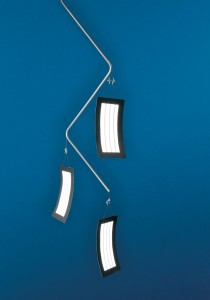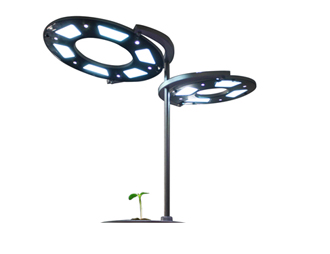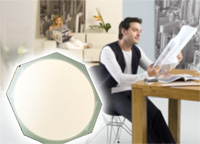Is OLED the new Disruptive Technology in Solid State Lighting?
OLED, or Organic Light Emitting Diodes are the new technology on the block, finding application first for the display market as an LCD replacement in the handheld battery powered devices such as cell phone displays. They have progressed to TV and computer monitors as replacement for traditional LCD with backlighting. Their ability to be manufactured as a thin sheet has allowed thickness reduction in these products and their high contrast ratios make them more than competitive with LCDs which require a backplane illumination.
But like the progression of their conventional brethren, the LED, they are following the path to another big volume application: Solid State Lighting. To date they have been hindered by a two major factors: (1) Relatively limited life compared with conventional LEDs (about 5,000 hours to the L50 (50% decrease in output) point compared with about 20-50,000 for conventional HB LEDS and (2) significant lower light output than HB leds ( about 25 lumens versus 100-150+ lumens for LEDS). However, their physical form is so radically different from conventional LEDs that their advantages for future lighting technology make them the next disruptive technology in SSL.
1) They are made in thin SHEETS as opposed to a die. Hence they look like glowing “paper” instead of a lighted transistor. The light is spread uniformly across the surface, eliminating the hot spots of multiple led lights. While they look like the old electroluminescent sheets that operated at high voltage/low current AC, these are true low voltage DC devices with drive requirements similar to LEDs.
2) They dissipate relatively little heat which is spread across the entire surface instead of a high density power point that requires often elaborate heat sinking in HB LEDs
3) Since they are not a POINT SOURCE of light, the optical problems and lens are eliminated. While not completely quite omni-directional, their inherent wide-pattern radiation make them logical replacements for fluorescent lights, a problem that HB LEDS have struggled with. Also this will make possible lighting “sheets”, to form lighted walls or lighted floors that are relatively inexpensive and could potentially revolutionize how we view lighting products and enable products never before possible.
4) The manufacturing process promises to make them at low cost in volume.
Now 5000 hours for a battery device that only lights a display for a limited time is fine for a cell phone. But a recent announcement states that Chinese OLED company Visionox and Tsinghua University have teamed up to develop a proprietary technology to increase the life of the panels. According to China Daily, the company has developed a new structure that delivers emission through a composite light emitting layer that prolongs the operational life of OLEDs by 20 times.
“Current commercially produced high-definition screens have a luminance ranging from 450 to about 1,000 cdm. However, though now used in small displays on cell phones and other devices, experiments show the technology provides a lifespan of up to 100,000 hours at a brightness of 1,000 cdm, one of the best records in the global industry.”
So the problem of life seems to solved and the brightness is making dramatic progress.
Also it should be noted that OSRAM introduced its Orbeos product recently as the first lighting product of its kind, a “Light Tile”. It has a an output of about 23 L /W http://www.osram-os.com/osram_os/EN/Products/Product_Promotions/OLED_Lighting/index.html
The typical Vf is very white LED-like 3.4 Vdc at 186 mA which is about 0.650 watts. The Color Temperature is warm white 2800K and the CRI is a lighting friendly 80.
It also appears that General Electric and Konica Minolta have been spending significant R&D resources in this field and have achieved the highest reported brightness so far:
56 lumens-per-watt efficiency achievement proves that flexible, white OLED lighting devices can be made at low cost using “solution-coatable” materials
NISKAYUNA, New York & CLEVELAND, Ohio (July 15, 2010)—GE Global Research, the technology development arm for the General Electric Company (NYSE: GE), GE Lighting and Konica Minolta (KM) have achieved a major breakthrough that brings the companies closer to making high-efficiency organic light-emitting diode (OLED) lighting devices a reality. GE and KM scientists have demonstrated illumination-quality white OLEDs using “solution-coatable” materials that are essential for producing OLEDs at a low cost.
Anil Duggal, GE’s OLED lighting technology leader, announced the efficiency milestone this week during a presentation at the International Symposium on the Science and Technology of Light Sources being held in Eindhoven, Netherlands.

“GE and KM have done what many in the OLED research community thought was not possible,” noted Duggal. “We have produced high-performance white OLED lighting devices with a commercially viable lifetime using ‘solution coating’ rather than ‘vacuum coating’ processes. This allows us to make use of the high volume roll-to-roll manufacturing infrastructure that already has been perfected in the printing industry.”
Lighting Industry, get ready for the next Big Thing!







